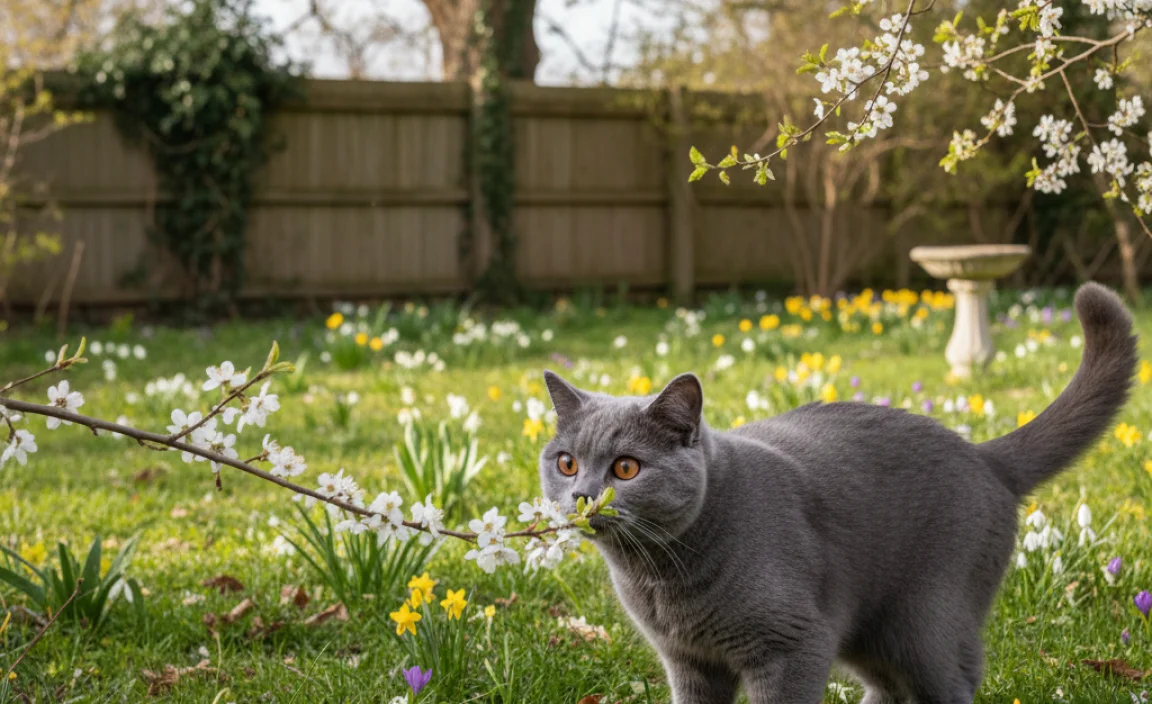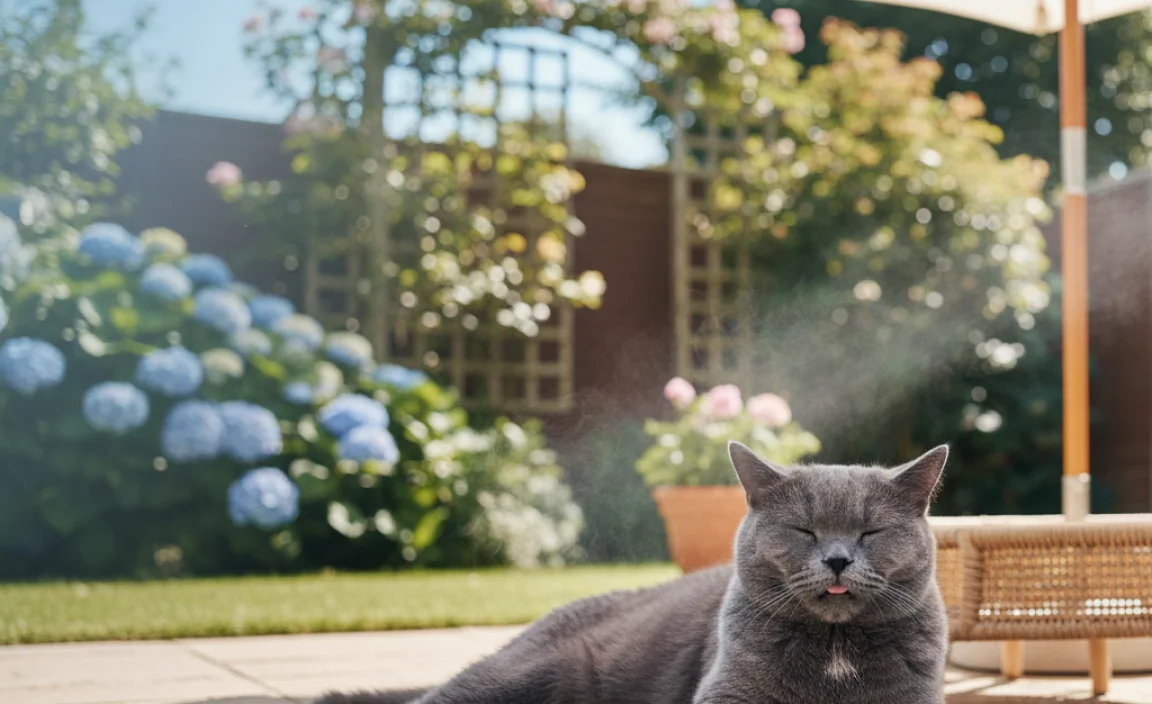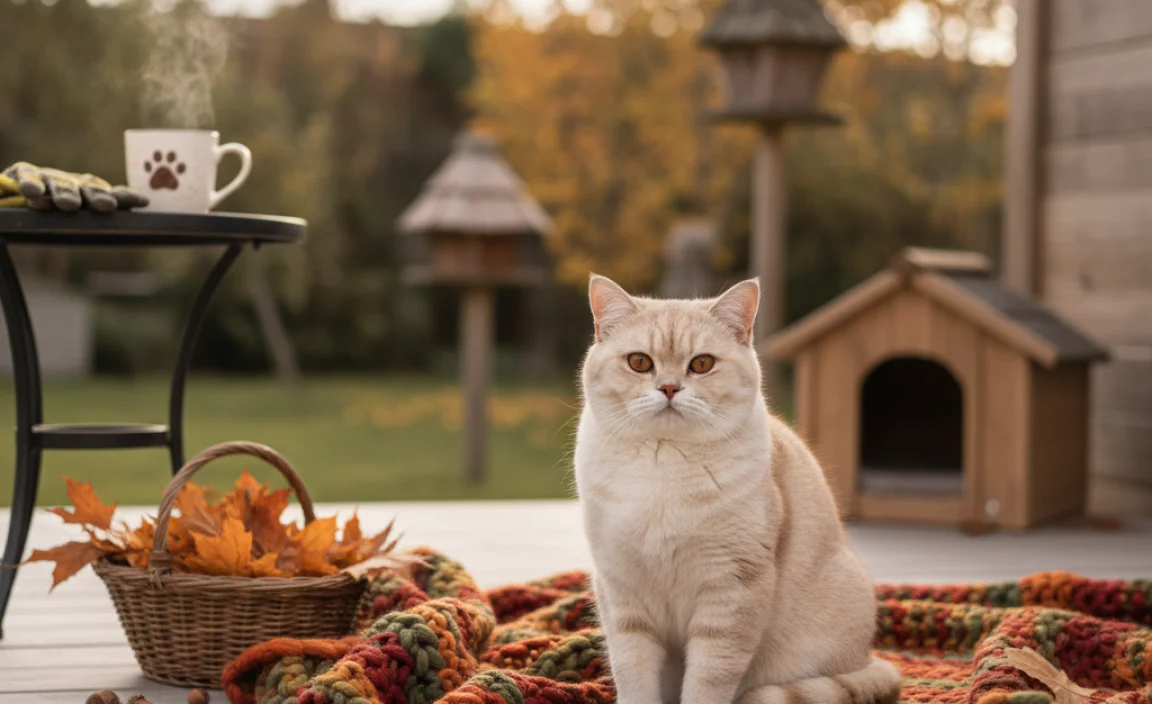Outdoor Seasonal Care for British Shorthairs: Easy Tips
Outdoor seasonal care for British Shorthairs involves protecting them from extreme weather: providing shade and fresh water in summer, and ensuring a warm, sheltered space in winter. Regularly check their coat for ticks or matting, and adjust their diet to match their activity level. Remember, British Shorthairs are primarily indoor cats and need supervision outside.
Worried about keeping your British Shorthair safe and happy outdoors throughout the year? You’re not alone! Many owners find it tricky to balance their cat’s desire for fresh air with the need to protect them from the elements. British Shorthairs, with their dense coats and charming personalities, need a little extra care to thrive outside in every season.
This guide will walk you through simple, effective ways to ensure your feline friend enjoys the outdoors safely, no matter the weather. From summer heat to winter chills, we’ll cover everything you need to know. Let’s get started and make outdoor time a joy for both of you!
Understanding Your British Shorthair’s Needs

Before diving into seasonal specifics, let’s understand the general needs of British Shorthairs when they venture outdoors. These cats are naturally curious but also quite content indoors. Their thick fur, while adorable, can be a double-edged sword, providing warmth in winter but potentially causing overheating in summer. Supervision is key to keeping them safe and comfortable.
- Supervision is Crucial: British Shorthairs should always be supervised when outdoors. This prevents them from wandering off, encountering predators, or getting into dangerous situations.
- Secure Environment: Ensure your outdoor space is safe and secure. A fenced yard or a cat-proofed balcony are ideal. Check for any potential hazards like poisonous plants or chemicals.
- Limited Time: British Shorthairs are primarily indoor cats. Limit their outdoor time to short, supervised sessions. This helps prevent overexposure to the elements and reduces the risk of injury or illness.
- Hydration: Always provide fresh water, especially during warmer months. Dehydration can be a serious concern for cats.
- Safe Havens: Offer access to sheltered spots where your cat can escape from sun, rain, or wind. This could be a shaded area under a tree or a covered patio.
Spring: Awakening and Outdoor Exploration

As the weather warms up, your British Shorthair might show more interest in the outdoors. Spring is a great time to reintroduce them to outdoor spaces, but it also brings specific challenges.
Springtime Concerns
- Allergies: Just like humans, cats can suffer from seasonal allergies. Watch for signs like sneezing, coughing, or itchy skin. Consult your vet if you suspect allergies.
- Parasites: Fleas, ticks, and other parasites become more active in spring. Ensure your cat is up-to-date on their preventative treatments.
- Gardening Hazards: Be mindful of pesticides, fertilizers, and poisonous plants in your garden. Keep these out of reach of your cat. The ASPCA has a comprehensive list of plants that are toxic to cats.
- Increased Activity: Spring often brings increased activity from other animals. Keep a close eye on your cat to prevent encounters with stray animals or wildlife.
Spring Care Tips
- Flea and Tick Prevention: Use a vet-recommended flea and tick preventative. These come in various forms, including topical treatments, oral medications, and collars.
- Allergy Awareness: Monitor your cat for allergy symptoms. If you notice anything unusual, consult your vet.
- Safe Gardening Practices: Avoid using harmful chemicals in your garden. Opt for natural pest control methods.
- Supervised Outdoor Time: Allow your cat short, supervised visits to the garden or balcony. This lets them enjoy the fresh air without the risks.
- Regular Grooming: Spring is shedding season! Brush your British Shorthair regularly to remove loose fur and prevent matting.
Summer: Keeping Cool and Safe

Summer heat can be particularly challenging for British Shorthairs due to their dense coats. It’s crucial to take extra precautions to prevent overheating and ensure their comfort.
Summer Challenges
- Overheating: British Shorthairs are prone to overheating in hot weather. Signs include excessive panting, drooling, and lethargy.
- Sunburn: Cats with light-colored fur are susceptible to sunburn, especially on their ears and nose.
- Dehydration: Cats can quickly become dehydrated in hot weather. Always provide access to fresh, clean water.
- Hot Surfaces: Patios, sidewalks, and other surfaces can become extremely hot in the sun, potentially burning your cat’s paws.
Summer Care Tips
- Provide Shade: Ensure your cat has access to shaded areas when outdoors. This could be under a tree, a patio umbrella, or a covered porch.
- Fresh Water: Always provide fresh, cool water. Consider using a pet water fountain to encourage drinking.
- Limit Outdoor Time: Restrict outdoor activities to cooler parts of the day, such as early morning or late evening.
- Cooling Mats: Offer a cooling mat or damp towel for your cat to lie on. These can help regulate their body temperature.
- Sunscreen: Apply pet-safe sunscreen to your cat’s ears and nose, especially if they have light-colored fur.
- Check Surfaces: Before letting your cat walk on outdoor surfaces, check the temperature with your hand. If it’s too hot for you, it’s too hot for them.
- Recognize Heatstroke: Know the signs of heatstroke and seek veterinary care immediately if you suspect your cat is overheating. Cornell Feline Health Center provides detailed information on heatstroke in cats.
Autumn: Preparing for Cooler Weather

As temperatures drop, it’s time to prepare your British Shorthair for the cooler months ahead. Autumn brings its own set of considerations, from changing weather patterns to increased shedding.
Autumn Considerations
- Shedding: British Shorthairs often shed more in the fall as they prepare for their winter coat.
- Temperature Fluctuations: Autumn weather can be unpredictable, with warm days and cool nights.
- Increased Indoor Time: As the weather cools, your cat may spend more time indoors, leading to potential boredom.
- Holiday Hazards: Be mindful of holiday decorations that could be harmful to your cat, such as tinsel, ribbons, and poisonous plants like poinsettias.
Autumn Care Tips
- Regular Grooming: Increase brushing frequency to manage shedding and prevent hairballs.
- Adjust Outdoor Time: Gradually reduce outdoor time as the weather cools.
- Provide Warm Bedding: Ensure your cat has a warm, comfortable bed to retreat to indoors.
- Indoor Enrichment: Offer plenty of toys and activities to keep your cat entertained indoors. Consider puzzle feeders or interactive games.
- Holiday Safety: Keep holiday decorations out of reach of your cat. Be especially careful with potentially toxic plants.
- Check for Drafts: Make sure your home is properly insulated to prevent drafts. Cats are more susceptible to cold when they are not active.
Winter: Staying Warm and Cozy

Winter presents the most significant challenges for outdoor care. British Shorthairs need extra protection from the cold to stay healthy and comfortable.
Winter Concerns
- Hypothermia: Prolonged exposure to cold can lead to hypothermia, a dangerous condition where the body temperature drops too low.
- Frostbite: Extremities like ears, paws, and tails are vulnerable to frostbite in freezing temperatures.
- Dry Skin: Indoor heating can dry out your cat’s skin, leading to itchiness and discomfort.
- Reduced Activity: Cats may become less active in winter, which can lead to weight gain.
Winter Care Tips
- Limit Outdoor Exposure: Minimize outdoor time during cold weather. Short, supervised visits are best.
- Provide a Warm Shelter: If your cat spends any time outdoors, offer a warm, insulated shelter. This could be a cat house or a covered porch with bedding.
- Heated Bed: Consider a heated cat bed to keep your cat warm and cozy indoors.
- Moisturize Skin: Use a pet-safe moisturizer to prevent dry skin.
- Monitor Weight: Adjust your cat’s diet to prevent weight gain due to reduced activity.
- Check Paws: After outdoor visits, check your cat’s paws for ice, snow, or salt. Wipe them clean with a damp cloth.
- Antifreeze Danger: Be extremely careful with antifreeze, which is highly toxic to cats. Clean up any spills immediately and store antifreeze out of reach. The RSPCA offers detailed advice on protecting pets from antifreeze.
Grooming for All Seasons
Regular grooming is essential year-round for British Shorthairs, but specific needs vary by season. Brushing helps remove loose fur, prevents matting, and allows you to check for any skin issues or parasites.
Grooming Essentials
- Brushing: Brush your British Shorthair several times a week, increasing frequency during shedding season.
- Nail Trimming: Trim your cat’s nails regularly to prevent overgrowth and injury.
- Ear Cleaning: Check your cat’s ears regularly and clean them as needed with a vet-approved solution.
- Dental Care: Brush your cat’s teeth regularly or provide dental treats to maintain oral hygiene.
Seasonal Grooming Adjustments
| Season | Grooming Focus | Tips |
|---|---|---|
| Spring | Shedding | Increase brushing to remove loose fur. Consider a deshedding tool. |
| Summer | Coat Maintenance | Regular brushing to prevent matting. Check for sunburn and parasites. |
| Autumn | Shedding | Increase brushing again as your cat prepares for their winter coat. |
| Winter | Dry Skin | Use a humidifier to add moisture to the air. Consider a moisturizing shampoo. |
Nutrition for Outdoor Activities
A balanced diet is crucial for maintaining your British Shorthair’s health and energy levels. Adjust their food intake based on their activity level and the season.
Nutritional Needs
- High-Quality Food: Choose a high-quality cat food that meets your cat’s nutritional needs. Look for options with real meat as the primary ingredient.
- Protein: Ensure your cat gets enough protein, which is essential for muscle development and energy.
- Hydration: Provide fresh water at all times, especially if your cat is active outdoors.
- Treats: Offer treats in moderation. Opt for healthy options like freeze-dried meat or dental treats.
Seasonal Dietary Adjustments
- Summer: Ensure your cat stays hydrated by providing wet food or adding water to their dry food.
- Winter: If your cat is less active in winter, reduce their food intake to prevent weight gain.
- Active Cats: If your cat is very active outdoors, they may need more calories to maintain their energy levels. Consult your vet for guidance.
Creating a Safe Outdoor Space
Whether you have a sprawling garden or a small balcony, creating a safe outdoor space for your British Shorthair is essential. Here are some tips to consider:
- Fencing: A secure fence is crucial for preventing your cat from escaping. Ensure the fence is tall enough and cat-proofed.
- Cat-Proof Balcony: If you have a balcony, use netting or mesh to create a secure enclosure.
- Enclosures: Consider building or purchasing a cat enclosure (catio) that allows your cat to enjoy the outdoors safely.
- Safe Plants: Choose plants that are non-toxic to cats. Avoid lilies, azaleas, and other poisonous varieties.
- Hiding Spots: Provide hiding spots where your cat can retreat if they feel scared or threatened. This could be a bush, a cat house, or a covered area.
- Climbing Structures: Offer climbing structures like cat trees or shelves to encourage exercise and exploration.
Recognizing and Addressing Health Issues
Even with the best care, your British Shorthair may encounter health issues related to outdoor activities. Knowing what to look for and how to respond can help keep your cat healthy and safe.
Common Outdoor Health Concerns
- Parasites: Fleas, ticks, and worms are common in outdoor cats. Use preventative treatments and check your cat regularly for signs of infestation.
- Injuries: Scratches, bites, and other injuries can occur during outdoor excursions. Clean wounds thoroughly and seek veterinary care if necessary.
- Allergies: Seasonal allergies can cause skin irritation, respiratory issues, and digestive problems. Consult your vet for diagnosis and treatment.
- Poisoning: Exposure to toxins like antifreeze, pesticides, and poisonous plants can be life-threatening. Seek immediate veterinary care if you suspect poisoning.
- Infections: Bacterial and fungal infections can occur from wounds or exposure to contaminated environments. Monitor your cat for signs of infection, such as swelling, redness, or discharge.
When to See a Vet
- Severe Symptoms: If your cat exhibits severe symptoms like difficulty breathing, seizures, or loss of consciousness, seek immediate veterinary care.
- Unexplained Changes: If you notice any unexplained changes in your cat’s behavior, appetite, or energy level, consult your vet.
- Wound Care: If your cat has a deep or infected wound, seek veterinary care to prevent complications.
- Parasite Infestation: If you suspect your cat has a parasite infestation, consult your vet for diagnosis and treatment.
- Allergic Reactions: If your cat has a severe allergic reaction, such as swelling of the face or difficulty breathing, seek immediate veterinary care.
FAQ: Outdoor Seasonal Care for British Shorthairs
Is it safe to let my British Shorthair outside?
Yes, with precautions! British Shorthairs can enjoy the outdoors with supervision. Ensure a secure environment, limit their time outside, and protect them from extreme weather.
How can I protect my British Shorthair from overheating in the summer?
Provide shade, fresh water, and limit outdoor activities to cooler parts of the day. Cooling mats and pet-safe sunscreen can also help.
What are the signs of hypothermia in cats?
Shivering, lethargy, and cold ears or paws are signs of hypothermia. Seek veterinary care immediately if you suspect your cat is hypothermic.
How often should I groom my British Shorthair?
Brush them several times a week, increasing frequency during shedding season (spring and autumn). Regular grooming helps prevent matting and hairballs.
What plants are poisonous to cats?
Lilies, azaleas, poinsettias, and many other plants are toxic to cats. The ASPCA has a comprehensive list of toxic plants. Always keep these out of reach.
How can I keep my cat entertained indoors during the winter?
Provide plenty of toys, scratching posts, and climbing structures. Puzzle feeders and interactive games can also help keep them engaged.
Should I adjust my British Shorthair’s diet during different seasons?
Yes, adjust their diet based on their activity level. Reduce food intake in winter if they are less active, and ensure they stay hydrated in summer.
Conclusion
Caring for your British Shorthair outdoors throughout the year requires a bit of planning and attention, but it’s well worth the effort to see your feline friend happy and healthy. By understanding the seasonal challenges and implementing the tips outlined in this guide, you can create a safe and enjoyable outdoor experience for your cat.
Remember, supervision is key, and every cat is unique. Pay close attention to your British Shorthair’s individual needs and preferences, and don’t hesitate to consult your veterinarian if you have any concerns. With a little care and consideration, you and your British Shorthair can enjoy the great outdoors together, no matter the season!



